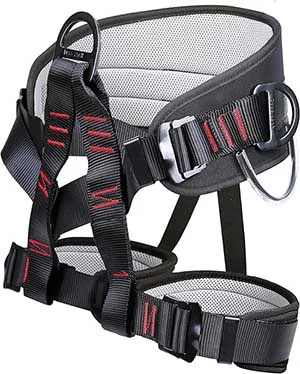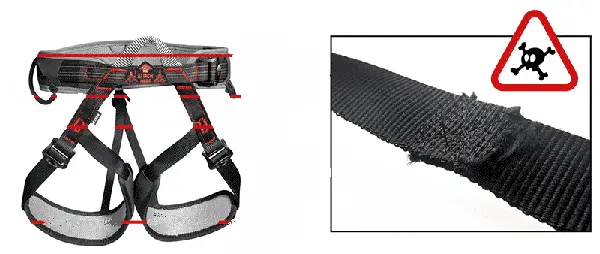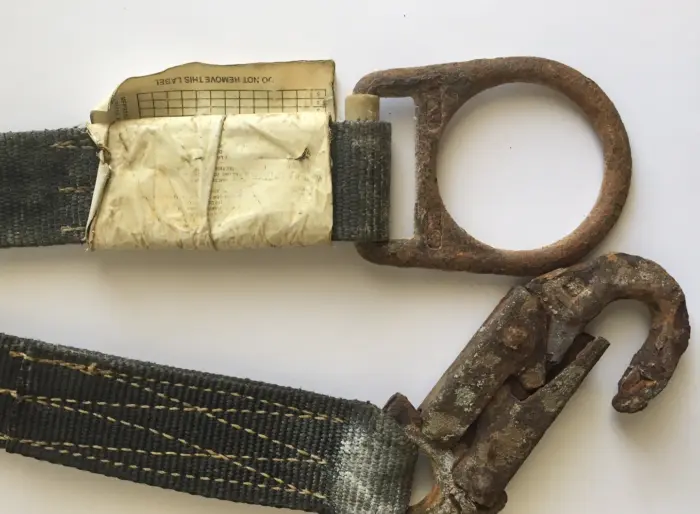Climbing harnesses are essential equipment for climbers, providing safety and support during their adventures on rocks, cliffs, or indoor climbing walls. Harnesses serve as a crucial link between the climber and the rope, distributing weight and absorbing energy in case of a fall.

However, like any gear used in high-intensity activities, climbing harnesses have a limited lifespan. In this article, we delve into the factors influencing the longevity of climbing harnesses and provide insights on how to determine when it’s time to retire them.
Factors Affecting Climbing Harness Lifespan
How Long do Climbing Harnesses Last?
Several factors contribute to the lifespan of climbing harnesses,
- With frequency of use
- Environmental conditions
- Storage plays a significant roles
It’s important to keep in mind that harnesses that are used frequently or exposed to harsh weather conditions may experience accelerated wear and tear compared to those used sparingly or stored in optimal conditions.

The quality of materials and construction can also influence durability, so it’s important to choose a harness that is well-made and suited to your specific needs.
Regular inspections and maintenance can help extend the lifespan of your harness and ensure its safety and reliability.
Normal Wear and Tear
- Understanding wear patterns
- When to inspect for damages
It is important to be aware of the typical wear patterns of climbing harnesses to assess their condition and ensure safety while climbing.
Over time, harnesses may show signs of wear such as frayed webbing, compromised stitching, or fading of materials. Regular inspections can help climbers identify potential issues and take appropriate action to address any wear and tear.
Indicators of Wear
- Frayed webbing
- Stitching integrity
- Aging of materials
It is important to regularly inspect climbing harnesses for signs of wear to ensure safety during climbs.

Look for frayed webbing, especially around high-stress areas like tie-in points and belay loops, as this can indicate potential weakness and should be addressed immediately.
Additionally, compromised stitching or visible signs of aging, such as stiffness or brittleness in materials, should prompt thorough inspection or replacement. Taking these precautions can help prevent accidents and ensure a safe climbing experience.
Manufacturer Recommendations
- Guidelines for replacement
- Manufacturer-specific insights
Climbers need to pay attention to the guidelines provided by climbing harness manufacturers regarding the lifespan of their products.
Factors such as usage and environmental conditions can impact the durability of a harness, so it’s crucial to follow these recommendations closely.
By doing so, climbers can ensure their safety and make informed decisions about when to retire a harness and purchase a new one.
Manufacturer-specific insights can provide valuable information that can help climbers make the best choices for their gear.
Personal Inspection and Maintenance
- Regular check-ups
- Cleaning and storage tips
It’s important for climbers to not only follow the manufacturer’s recommendations but also conduct regular inspections and maintenance routines for their harnesses.
Simple tasks such as cleaning dirt and debris, avoiding prolonged exposure to sunlight, and storing harnesses in a cool, dry place can help extend their lifespan.
Regularly checking for signs of wear and addressing them promptly can prevent accidents and ensure continued safety. It’s crucial to prioritize the maintenance of climbing equipment to ensure optimal performance and safety.
Retiring Old Harnesses
- Safe disposal methods
- Recycling options
It is important to properly retire climbing harnesses when they reach the end of their usable lifespan or show significant signs of wear.
Safe disposal methods, such as cutting the harness into pieces to prevent accidental reuse, or utilizing recycling options provided by some manufacturers, can help minimize environmental impact.
This ensures that the materials are properly handled and disposed of in an environmentally conscious manner.
Budget Considerations
- Balancing cost and safety
- Investing in quality
When it comes to replacing climbing harnesses, safety should always be the top priority. However, it’s also important to consider budget constraints.
Finding a balance between cost and safety involves carefully evaluating the quality and features of available harnesses.
Look for options that offer the best combination of durability and affordability to ensure that you are getting a safe and reliable harness within your budget.
Replacing Components vs. Entire Harness
- Assessing options
- Cost-effectiveness
In some cases, climbers may encounter minor damage to specific components of their harnesses, such as buckles or gear loops.
While replacing individual components is an option, it’s essential to assess the overall condition of the harness and consider whether investing in a new one would be more cost-effective and safer in the long run.
Extending Harness Lifespan
- Proper usage techniques
- Upgrading features
Climbers need to take proactive measures to extend the lifespan of their harnesses. By avoiding abrasive surfaces, minimizing exposure to chemicals or harsh weather, and investing in harnesses with reinforced high-wear areas.
Climbers can help prolong the usability of their gear. Additionally, practicing proper usage techniques can also help extend the lifespan of harnesses.
These steps can help ensure that climbers can continue to use their harnesses safely and effectively for a longer period.
Safety Precautions
- Importance of safety in climbing
- Risks associated with worn harnesses
Additionally, proper training and education on climbing techniques and safety procedures are crucial for all climbers.
It’s important to always double-check equipment, such as ropes, carabiners, and anchors, before each climb to ensure they are in good condition.
Climbers should also be aware of their physical limitations and be prepared for unexpected situations. By prioritizing safety and staying vigilant, climbers can minimize the risks associated with this adventurous activity.
Expert Recommendations
- Insights from experienced climbers
- Best practices for harnessing longevity
It’s important for climbers to pay attention to harness maintenance and safety practices, and to seek advice from experienced climbers and industry experts.
By learning from their experiences and following their recommendations, climbers can make informed decisions about gear usage and replacement, which can ultimately improve their safety and enjoyment of the sport.
Case Studies
- Real-life examples
- Lessons learned
Certainly! One real-life example of a climbing accident due to gear failure occurred in 2017 when a climber fell to his death in Yosemite National Park.
An investigation revealed that the climber’s harness had been worn out and should have been replaced. Another example is the 2015 accident in which a climber fell after his worn-out harness failed to hold him.
These incidents highlight the critical importance of regularly inspecting and replacing climbing harnesses and gear.
By learning from these case studies, climbers can better understand the potential risks and take proactive measures to ensure their safety while climbing.
Proper maintenance and replacement of harnesses and other gear are essential for preventing accidents and ensuring a safe climbing experience.
Conclusion: How Long do Climbing Harnesses Last?
Climbing harnesses are an essential piece of gear for any climber. They provide crucial support and safety during your adventures on the rock.
It’s important to understand the factors that can influence the lifespan of your harness, as well as recognize signs of wear and tear. Following the manufacturer’s recommendations for care and maintenance is essential for ensuring your safety while climbing.
Regular inspections, maintenance, and proper disposal of old harnesses are all important steps to take to ensure your safety. By prioritizing these measures, climbers can enjoy their adventures with confidence and peace of mind.
FAQs: How Long do Climbing Harnesses Last?
How often should I inspect my climbing harness for wear and tear?
It is important for climbers to inspect their harnesses before each use and to conduct thorough checks periodically, especially after intensive use or exposure to harsh conditions.
This is to ensure that the harness is in good condition and that all the components are functioning properly. Regular inspections can help prevent accidents and ensure the safety of the climber.
Can I repair a worn climbing harness myself?
It’s important to keep in mind that while minor repairs can often fix issues with structures or equipment, significant damages or compromises in structural integrity may warrant replacement rather than repair attempts.
It’s essential to prioritize safety and ensure that any repairs are effective and won’t compromise the overall integrity of the structure.
If you’re unsure about whether to repair or replace something, it’s always best to consult with a professional to assess the situation and make an informed decision.
What are the risks of using a worn climbing harness?
It’s important to regularly inspect and replace worn harnesses to prevent accidents and potential gear failure. Safety should always be a top priority when it comes to any outdoor activities or work at heights.
Proper maintenance and care of harnesses can help reduce the risk of injuries or fatalities.
Are there specific storage guidelines for climbing harnesses?
It’s important to store harnesses in a cool, dry place away from direct sunlight and chemicals. Doing so can help prolong their lifespan and maintain their integrity.
This will ensure that they are in good condition and safe to use when needed.
When should I consider upgrading my climbing harness?
Signs of wear and tear. Newer harness models often come with updated safety technology and materials that provide improved support and protection.
It’s important for climbers to regularly inspect their harnesses for any signs of damage or wear, and to replace them as needed to ensure their safety while climbing.
Additionally, newer harnesses may offer a better fit and increased comfort, making them a worthwhile investment for avid climbers.


